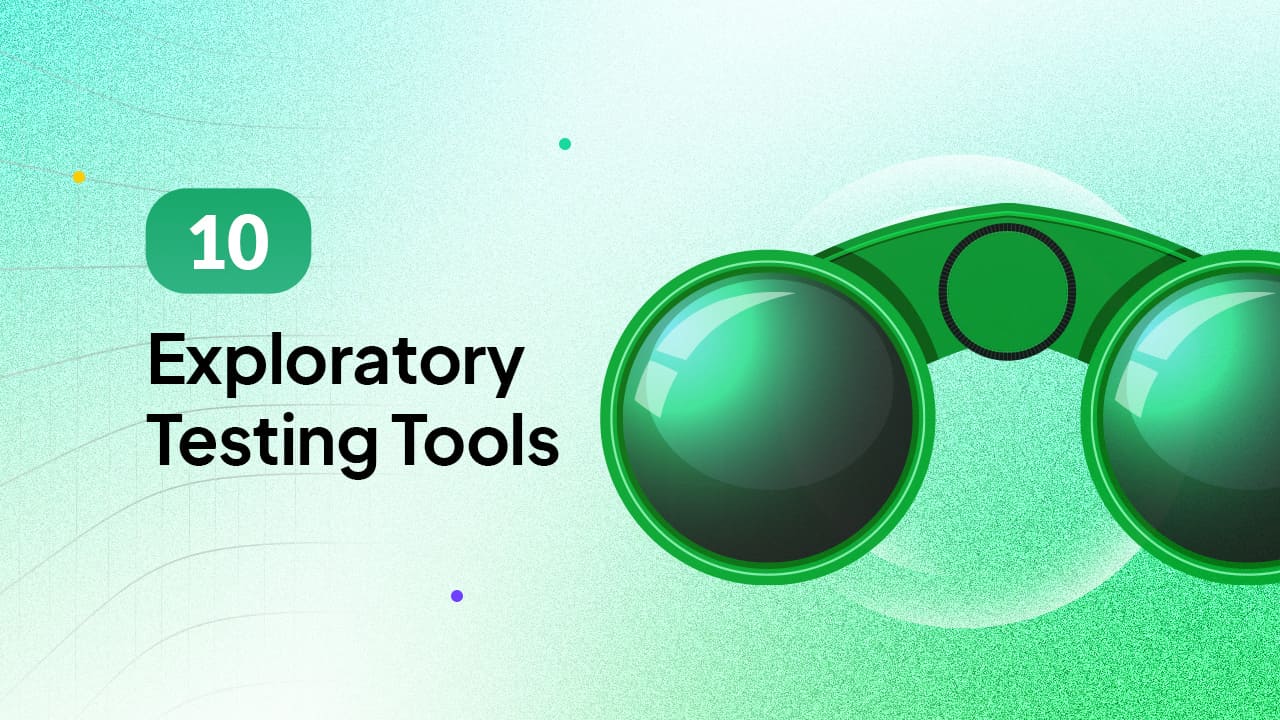Top 10 Exploratory Testing Tools In 2025

Exploratory testing is often called ad hoc testing. Software testing expert Cem Kaner introduced the term in his book Testing Computer Software. For example, testers test a travel app to reserve hotels, search for fun centers, connect with travelers, and test other app features. Here comes the exploratory approach to verify that the app works as expected. In software testing, exploratory testing is described as simultaneous learning, test design, and execution.
The top exploratory testing tools are useful for performing testing activities like writing, mind mapping, recording, taking screenshots, and more. This type of testing may not always focus on core testing but can help identify hidden bugs. Other benefits of these tools are real-time decision-making, easy optimization, extensive test coverage, and better collaboration among teams. Let’s uncover some of the best exploratory testing tools with features, pros, and cons.
10 Best Tools For Exploratory Testing
1. ACCELQ
ACCELQ redefines the manual testing experience by offering a structured yet flexible approach to testing applications. Harnessing the power of AI and intelligent automation, ACCELQ ensures that testers can seamlessly transition from scripted to exploratory testing without losing track of test coverage or documentation. This test automation platform can uncover critical issues, gain real-time insights, and optimize application quality through intuitive, visual-based workflows that require no prior coding expertise.
Features:
- ACCELQ develops automation test logic in plain English concurrently with application development.
- An analytic runtime engine of this platform ensures a reliable test execution by intelligently adapting to unexpected application changes.
- Universe-based visual application modeling.
- AiRecorder, coupled with a powerful natural language editor, allows you to record test automation logic with zero code.
- ACCELQ embeds a design-first approach with inbuilt modularity and reusability for scalable and low-maintenance automation.
- Data-driven scenarios and test case data are inherent to scenario design.
- Automated test case generation with proven risk coverage assurance is supported.
- Native integration with CI/CD tools, such as Jira, Jenkins, and others, is supported to ensure test automation is integral to the development lifecycle.
- The platform tracks and documents every exploratory session with detailed logs, ensuring complete traceability of testing activities.
- ACCELQ redefines traceability with the intelligent, connected test repository.
- This platform supports built-in test management, version control, and governance capabilities.
- ACCELQ enables agile delivery with a continuous action dashboard that provides an integrated view of the entire SDLC status.
- The platform can review the associated bugs in a test report during exploratory testing sessions.
- ACCELQ restricts application access via Oauth 2.0-based security and tenant group access policies.
Pros & Cons of ACCELQ
- Intuitive, codeless interface for easy use
- Seamless integration with test management
- AI-driven insights for better coverage
- No cons
2. Azure Test Plans

Azure test plans improve code quality by using planned and exploratory testing services for apps. This tool can test applications by executing tests across desktop or web apps.
Features:
- Plans scripted tests with actionable defects and end-to-end traceability.
- Scripted tests get executed with actionable defects and end-to-end traceability.
- Tracks scripted tests with actionable defects and end-to-end traceability.
- Captures rich scenario data when tests are executed to make discovered defects actionable.
- Design and execute tests simultaneously to maximize quality using exploratory test sessions.
Pros & Cons of Azure Test Plans
- Test & Feedback extension
- Captures application interactions via images or video
- Uses test-specific work item types to plan and author tests
- Less documentation
- Complex user experience for beginners
- Project management needs improvement
3. XRay

The XRay exploratory app is one of the tools for exploratory testing, consisting of two primary components: a desktop application and a web console. The desktop application works standalone or integrates with XRay and Jira. The web console allows you to register as a user and manage test sessions and team workspaces.
Features:
- Desktop applications can create new generic tests on this tool.
- The component desktop application defines new exploratory testing sessions.
- Desktop application executes sessions for existing generic and manual tests.
- Record videos, capture screenshots, take notes, and upload files to save them on the session.
- Uploads test evidence and reports to this tool.
Pros & Cons of XRay
- Capture and document bugs by using video recordings and notes to identify issues
- Save test results as PDFs and attach them directly to Jira
- Access test sessions from any device
- Setup can be time-consuming for new teams
- Ideal for teams using Jira or standalone tools
- High cost based on users and features needed
4. Bug Magnet

Bug Magnet is an exploratory testing assistant for Chrome and Firefox. Common problematic values and edge cases can be added to the context menu for editing elements, allowing users to access them easily during exploratory testing sessions.
Features:
- Convenient access to edge cases for exploratory testing is supported.
- This tool works on input fields, text areas, and content-editable DIVs.
- Inject values using JavaScript or using clipboard events to simulate user workflows.
- This tool loads your config files easily.
Pros & Cons of Bug Magnet
- Easy to use as a browser extension
- Test data for quick input
- Boosts exploratory testing with data variability
- Limited to browser testing
- Lacks advanced reporting
- No integration with issue-tracking tools
5. SpiraCapture

SpiraCapture is a free browser extension for Chrome and Edge that streamlines and improves app exploratory testing. The extension intelligently records and organizes testing sessions.
Features:
- Record tabs in Chrome or Edge.
- Track actions such as clicks and keystrokes automatically on each tab being recorded.
- This extension captures data to know what was clicked.
- Testers can select each recorded event and save it as an incident in a test management platform.
Pros & Cons of SpiraCapture
- Simple interface for quick setup
- Real-time collaboration during testing
- Automatically records actions for better tracking
- Requires SpiraTest for full functionality
- Limited customization for test sessions
- Resource-heavy during long testing sessions
6. Zephyr

Zephyr is a test management system based on a realistic approach to how QA teams work, collaborate, and interact with each other. The Zephyr exploratory tool is an extension that must be downloaded and installed from the Google Play Store.
Features:
- Test case reordering in the test repository.
- Test case versioning and sharing.
- Global and project test case repositories are supported.
- Test steps can be copied and deleted for individual test cases.
- Test cycles can be hidden and unhided.
- Release requirement repository.
- Dashboard.
Pros & Cons of Zephyr
- Organize test cases by versions for streamlined execution and results
- Integrates with popular tools for seamless testing and development
- Dashboards to share test results with stakeholders
- Reduced performance in complex test environments
- Requires training.
- Limited customization.
7. TestRail

TestRail is a web-based test case management tool to manage, track, and organize exploratory testing efforts. With this tool web interface, testers can design test cases, organize test suites, execute test runs, and track the results, ensuring a streamlined approach to exploratory testing.
Features:
- Creates and manages unique test case fields, like multi-line text fields, to detail goals during exploratory sessions.
- Defines a group of tests to be run, assigns tests to team members, and executes all tests to record results.
- Groups and executes many test runs to test applications against different operating systems, browsers, and devices.
- This tool links to and pushes defects to issue-tracking tools like Jira to report bugs.
- Generates detailed project reports, tracks test coverage, and builds traceability between requirements, tests, and defects.
Pros & Cons of TestRail
- Centralized repository for managing test cases, suites, and plans
- Organize tests by milestones, versions, and configurations
- Detailed reports and metrics to track progress
- Difficult setup
- Performance issues with large datasets
- High cost
8. Testmo

Testmo is a test management tool. It can perform exploratory testing and test session management for fast-release cycles.
Features:
- Tracks test sessions during exploratory testing.
- Rich test session note-taking, including accurate time tracking and test results, is supported.
- Create and link issues with an issue tracker for an integrated workflow.
- This tool can customize session fields, templates, and project configurations.
- Import and reuse sessions.
Pros & Cons of Testmo
- Integrates with issue tracker and existing CI/CD pipelines
- Rich reports are supported to track exploratory testing efforts
- Flexible in configuring workflows
- Needs stable internet for best performance
- Steep learning curve
- High cost
9. Tricentis qTest

Tricentis qTest is one of the automated exploratory testing tools used to perform testing, automate scripting, capture test sessions, and report bugs. qTest Explorer is a test execution recorder and documentation tool for exploratory testing.
Features:
- Intelligent capture technology tracks all interactions from the testing session and automatically creates defect documentation.
- Share defect documentation with other team members via tickets or documents.
- The sessions module collects test session data in one central location to review any planned, running, reviewed, or completed exploratory testing sessions.
- Edits or deletes individual screens and annotates with arrows, notes, and a blur tool.
- Export defects to Word, PDF, or JPEG files.
Pros & Cons of Tricentis qTest
- Intuitive field customization for mapping complex workflows
- Creates, edits, and organizes test cases with ease
- Smooth Jira and Selenium integration for automated script
- Defect search can be challenging
- Requires extensive integration capabilities
- Complex UI for mobile app navigation
10. Testuff

The Testuff platform is available as a desktop and web-based client. The platform provides detailed support for exploratory software testing. The Jira App integrates with this platform to streamline issue-tracking and project management processes directly within Jira.
Features:
- This platform organizes tests by projects, branches, and hierarchical suites.
- Test case management.
- Video recording capabilities allow to send information directly to the issue tracker.
- Simultaneous integration with any number of bug trackers is supported.
- Reports.
Pros & Cons of Testuff
- Comprehensive audit trail
- Integration with many bug trackers is supported
- Simple license management
- Setup is complex
- Complex integration
- Requires skills and experience
Conclusion
Exploratory testing is crucial in software testing, which involves exploring the software application to find defects. With the increasing complexity of modern software applications, it has become more critical than ever. Various tools ease exploratory testing and make it effective and efficient. The right tool will allow you to validate the software application against any bug and ensure its quality before release.
ACCELQ breaks all silos between manual and automated testing with its cloud-based AI codeless test automation platform. This platform seamlessly automates API and web testing and can be integrated with the manual testing process, enabling Agile teams to manage the entire QA lifecycle effectively. Enterprises of all sizes can use ACCELQ to accelerate their exploratory testing by adapting to the automation approach that spans test design, planning, generation, and execution. Start your free trial today and unlock a seamless test automation experience.
Discover More
 15 Best Mobile Testing Tools
15 Best Mobile Testing Tools
15 Best Mobile Testing Tools
 Top 12 Test Automation Tools of 2025
Top 12 Test Automation Tools of 2025

































